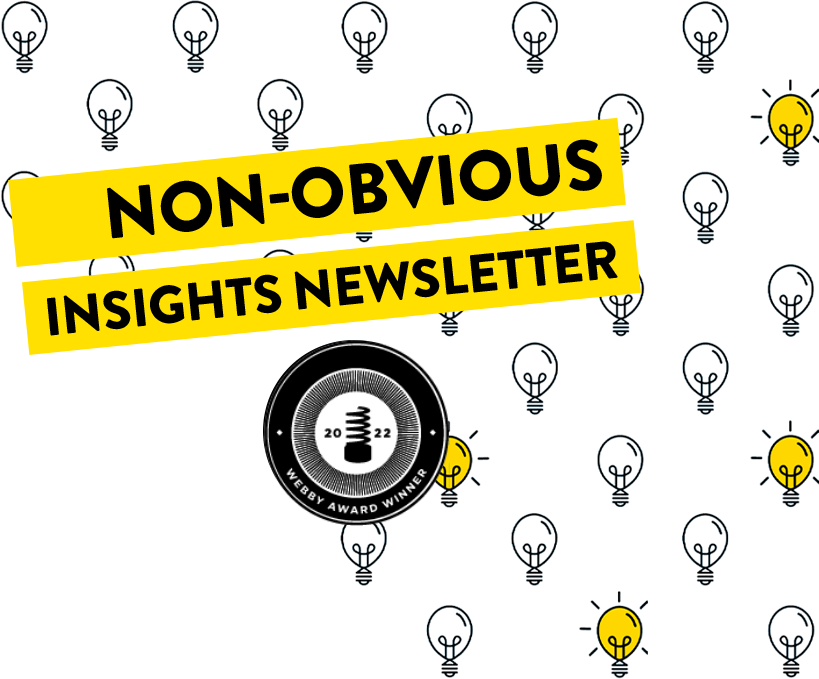Dear Fellow Trend Curator,
I’m back after a short 2-week break as a traveled to Paris to experience my 6th Summer Olympics and as I wrote last week, I still believe the event is unlike any other (and you should definitely go to LA 2028 if you can make it). As I write this, I realize we’re in the midst of a political convention in America, many kids are heading back to school and the Northern hemisphere summer comes to a close … the Olympics probably seem like a distant memory.
To help get us all back into the rhythm of life, this week’s stories range from the DNC convention and what Democrats are getting dangerously wrong to how Crocs is taking a page from the LEGO marketing playbook. I’m also continuing my weekly feature of the Non-Obvious Book of the Week selection with a book that is sure to get you back into the swing of school and work with techniques to learn faster and better in any situation.
Enjoy the stories and stay non-obvious!
Rediscovering the Beauty of the Archive
Since starting my blog in 2004, I’ve easily written more than a thousand articles. When you add in books and social media posts, that’s a whole heap of content. While some of it is outdated, since there’s no easy way to resurface this past thinking, it all remains buried. This week I read an article that explored the curious popularity of an archival social media account created by public television employee James Auclair to share old b-roll clips of daily life from the 60s and 70s. They have gone viral.
The grainy videos offer up a snapshot of a lost world and encourage people to lean into the nostalgia of remembering a time without smartphones and AI that just felt simpler. These videos offer the experience of “time-traveling back to some precise moment where nothing of note happened,” while also helping us appreciate the progress baked into the way we live our lives today. The story got me thinking about the importance of bringing some of my own “old” content back to life. What insights might I rediscover to share with you from something I wrote five, ten or even fifteen years ago? I’m going to start looking at this and I’ll come back to share what I discover in a few weeks.
What the Democrats Are Getting Wrong About Media at the Convention
One of the truths about our new media environment is the central role that influencers are taking in the content people consume and trust. Particularly when it comes to young people and their media diet … so it’s no surprise that politicians are courting these influencers and hoping they can help inspire the younger generation to come out and vote. At the Democratic National Convention this week, influencers have taken such a central role that they have been credentialed and treated like VIPs.
Unfortunately, the traditional media doesn’t seem to be getting the same sort of treatment. While influencers enjoy free wine, dedicated space and exclusive access, members of the media report struggling to find working power outlets. Offering influencers and “real people” a chance to cover the convention is a great and overdue shift. The problem is that it seems to be happening at the expense of actual journalists as they “battle for space” at the convention.
Influencers aren’t the same as journalists.
An influencer has no obligation to follow any code of ethics. They offer opinion and (often) entertainment. Can their coverage be authoritative and important? Absolutely. But this is not a substitute for actual journalism. The choice convention organizers seem to have made to prioritize influencers above reporters is a dangerous one. It suggests that opinion matters more than thoughtful journalism.
At a time when we need to elevate trained journalists instead of diminishing them, the DNC is getting it wrong. Influencers have an important perspective to share and deserve a seat at the table. Journalists have earned that same seat too.
How Crocs Is Taking a Page from LEGO’s Marketing Playbook
Brand partnerships can be tricky. One partner may eclipse the other. It can be hard to stand out or make the right commitments. I’ve always admired the way LEGO used partnerships to leverage the content and stories of their partners but add their own unique lens through the various items you could build through co-branded LEGO sets with nearly every popular movie franchise series, from Marvel to Harry Potter. Recently, some lists of the many varied collaborations the Crocs brand has been doing are starting to get featured. The breadth of these partnerships is impressive and has played a big role in helping transform their brand reputation from the ultimate ugly footwear to an unabashed self-described “comfort brand.”
This shift is already described by some industry observers as “one of the great brand turnaround stories.” From celebrity collabs with music stars like Luke Combs or Bad Bunny, to branded shoes for household names like Pringles or Jolly Ranchers, to movie tie-ins with brands like Star Wars or SpongeBob – the full gallery of all the designs is extensive.
In a World of Digital Silence, What Should Anything Sound Like?
Electric cars are quiet. Maybe too quiet. The problem, as some public health groups warn, is that electric cars dramatically increase the risk of accidents with pedestrians. The absence of sound creates danger, because we expect to be able to hear a car coming. Now that legislation spearheaded by groups advocating for the blind and visually impaired is starting to require electric vehicles to emit “an artificial engine noise,” the new challenge is what this sound should be. Do car makers just copy the engine sound from existing cars? And if so, which car? Should all electric cars be required to sound the same?
While the question may seem unique to vehicles, a similar challenge has come up with other technology too. Digital cameras and smartphones, for example, generally now have an option to turn on an artificial shutter sound so you can audibly hear that a photo was taken. Digital doorbells simulate the sound of a bell even though they don’t always have a physical bell attached anymore. Car horns, bike bells, smoke detectors and countless other products that have gone digital also have a similar sonic challenge of creativity. Should the sounds each of these things make just aim to copy the current analog sound or is this a chance to rethink old conventions? I’d love to hear what you think. Just hit reply to this message and let me know!
Southwest Airlines Is Killing Their Open Seating Policy and I’m Confused …
Let me go on record saying that I think open seating on an airline flight is an idiotic idea. I’ve always hated it, and generally avoided flying Southwest Airlines partially because of this. The concept that you can’t book an actual seat and instead have to arrive early and wait in a line just so you can get the best possible seat is something I might have done in my 20s to get into a concert. But now in my 40s boarding a flight, it’s a level of uncertainty that feels totally unnecessary. The announcement that the airline is (finally) killing this policy was welcome news for me as an avid traveler, but I realize that I might not represent the views of many of their customers.
Analysts and customers are openly wondering if this move is likely to backfire for Southwest, removing part of what made them different from all their competitors for so many decades. This seems to suggest that open seating was popular. Since I generally fly United (they have the most non-stop flights across the world from my DC-based home airports), I’m not the best judge of whether this will hurt the airline. If you fly Southwest, will their shift to assigned seating affect your choice to fly with them or not? Perhaps people really do love the chaos and stress of not knowing if they’ll end up with a middle seat or not until they board a flight. Southwest Airline frequent fliers and brand fans, what am I missing?
The Non-Obvious Book of the Week
Ultralearning by Scott H. Young
As we head into the end of the summer and back to school times, learning might be on your mind and everyone else in your family too. Learning, of course, isn’t just for school and one of my favorite books all about how to learn better is Ultralearning by Scott H. Young. Nearly every page of this book is full of useful and non-obvious advice. Take notes as questions instead of answers. Attack your weakest point and learn that thing you find most difficult. If you care about long term retrieval, spend more time learning something instead of cramming.
The book not only shares short techniques like this, but it also maps out a process for putting those into action for everything from acquiring a new expertise to learning a new language. If you’re looking for an edge to learn something faster or want to help yourself become a better student of anything … this book has some ideas to help.
About the Non-Obvious Book Selection of the Week:
Every week I will be featuring a new “non-obvious” book selection worth sharing. Titles featured here may be new or from the backlist, but the date of publication doesn’t really matter. My goal is to elevate great books that perhaps deserve a second look which you might have otherwise missed.
Even More Non-Obvious Stories …
Every week I always curate more stories than I’m able to explore in detail. Instead of skipping those stories, I started to share them in this section so you can skim the headlines and click on any that spark your interest:
- The 24 Wildest Popcorn Buckets Inspiring People to Actually Collect Them (And Go See the Movies)
- What Happens to Babies Born on Planes?
- The Magical Charger That Takes Less Than 5 Minutes to Charge Your Phone May Soon Be a Reality
- 200 Years Ago, There Used to Be A 27th Letter in The English Language Alphabet
How are these stories curated?
Every week I spend hours going through hundreds of stories in order to curate this email. Looking for a speaker to inspire your team to become non-obvious thinkers through a keynote or workshop?
Watch my new 2024 speaking reel on YouTube >>
This Non-Obvious Insights Newsletter is curated by Rohit Bhargava.
Copyright © 2023 Non-Obvious, All rights reserved.
Get this newsletter directly in your inbox every Thursday! Subscribe here >>





